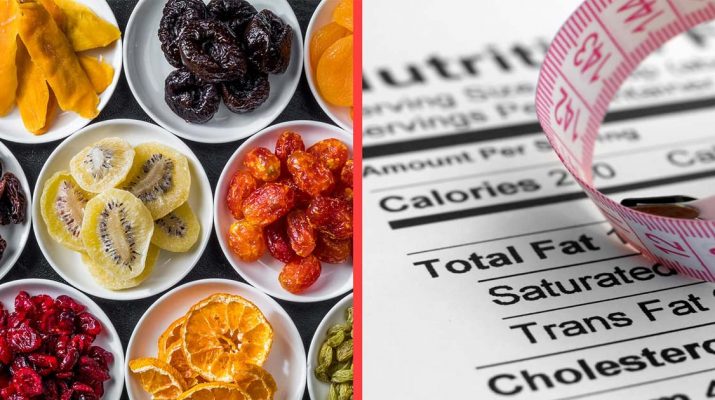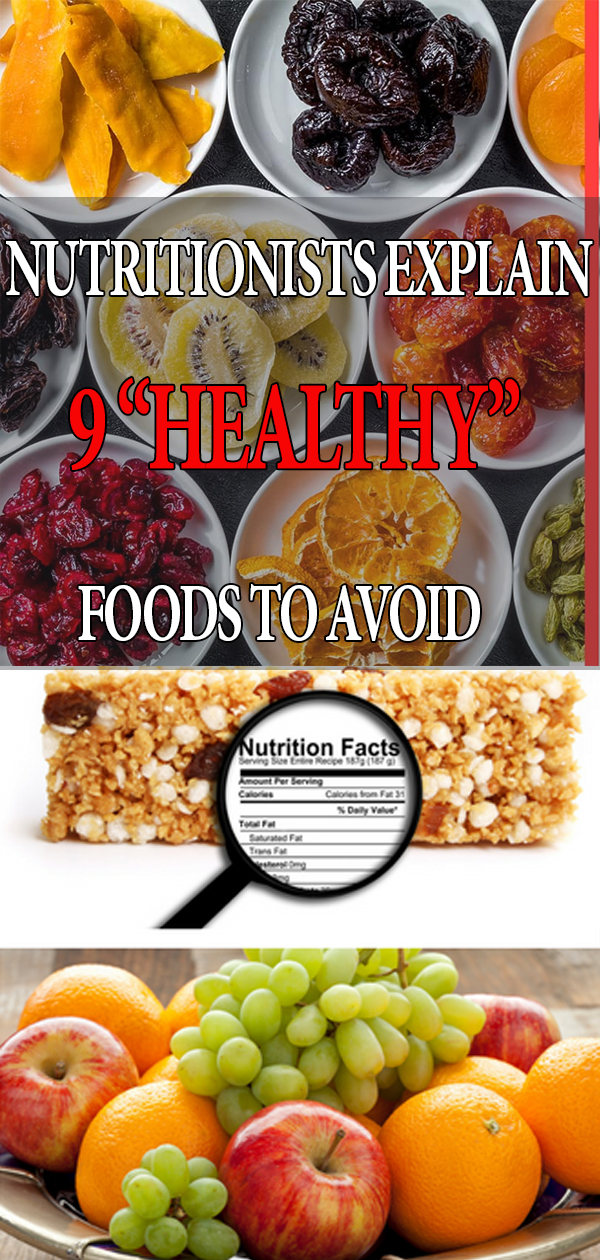In today’s increasingly health-conscious world, we have tons of new options for good alternatives to bad foods. But what if a lot of these weren’t actually as healthy as we’re lead to believe?
Unfortunately, clever marketing has us fooled into believing a lot of damaging food options are good for us. It’s important that you know what’s really healthy and what’s all a ruse.
Here’s How Nutritionists Explain 9 “Healthy” Foods To Avoid
1. Fruit Juices And Smoothies
Many people think that if fruit is healthy, smoothies and juices made from them should be just as healthy. But this isn’t the case. Supermarket juices are largely filled with a mix of chemicals that are artificially flavored and colored to taste and appear more appetizing. Worse still, they’re stuffed with sugar.
- You can opt for 100% pure, freshly squeezed fruit juice instead – but it’s still not your best bet.
- Fruit juice is basically fruit without fiber and a lot of the nutrients, which leaves only one thing behind – sugar.
- Yes, it’s healthier sugar than the white, refined varieties, but it’s sugar nonetheless.
- You should just eat the fruit directly.
- The same goes for those green smoothies and juices touted by health nuts.
In fact, Registered Dietitian Nutritionist Ilyse Schapiro gives them to clients who need to put on weight, not lose weight. This is because your body starts getting ready to digest foods when it’s chewing.
Drinking does not start this process.
Let’s put it this way – any type of fruit juice likely has as much sugar as a drink you consider to be unhealthy, so it’s definitely a “healthy” food to avoid. Your best bet is to drink unsweetened tea, seltzer, or, better yet, just water.
2. Vegan, Vegetarian, Gluten-Free, Or Low-Carb Junk Food
Many people equate veganism with health. If a certain food is vegan, it’s probably good for you, right? After all, everything comes from a plant. Wrong! Just because something starts out as a plant, doesn’t mean it doesn’t end up bad for you – take potato chips, for example.
The same goes for low-carb snacks, such as the ever-famous Atkins bar. Take a look at the list of ingredients on the back and see if there’s any real food in there. It’s all artificial, and there’s nothing there that gives your body the nourishment it needs.
Then, there’s gluten-free food. Sure, eating less gluten can have positive results for many people. But junk food of this type is still made using refined forms of starch that have the same bad effect on glucose in the blood.
Unfortunately, the fact is that all processed food remains just that: processed food. They’re stuffed with bad chemical products that add no health benefits. Essentially, they’re just as bad as any high-carb, non-vegan junk food out there. Tacking on the word “gluten-free” doesn’t make junk food less junk-filled.
3. Seed And Vegetable Oils
Regular cooking oil has been pushed aside due to the fact that it is bad for the cholesterol, and this is a smart decision. But a lot of people have then redirected their attention to vegetable, fruit, and seed oils, such as:
- Canola oil
- Soybean oil
- Grapeseed oil
- Sunflower oil
- Corn oil
- Cottonseed oil
Why are we so accepting of these types of oils? Well, studies have shown that they have positive effects on cholesterol, lowering their levels in the blood. With that being said, this only occurs on a short-term basis.
Perhaps more crucially, it is important to note that blood cholesterol adds to the risk of disease, but isn’t actually a disease that needs to be stopped; it just has to be managed and balanced. This means that no matter how much lower these levels get after consuming veggie oils, these oils cannot completely stop the development of disease.
Further research has actually revealed that even though they help bad levels of cholesterol, seed and vegetable oils still increase the risk of developing conditions like cancer and heart disease. As such, they’re not nearly as healthy as we have been led to believe.
Vegetable and seed oils are still better than normal cooking oils, but they are still processed and therefore aren’t nearly as good for you as natural fats. Options such as olive oil, butter, and even coconut oil are much safer.
4. Agave Nectar
More and more people are becoming wise to the dangers of sugar. That’s why they’ve gone looking for possible replacements for refined granules. One such replacement is Agave nectar, which is a kind of syrup commonly used in “healthy” foods. It is touted as being natural and, therefore, safe for you.
Unfortunately, some elements of Agave nectar are worse than sugar. To understand this, let’s look at why sugar is bad for us. Sugar contains a lot of fructose; about 50% of it is made of this component. Fructose, in turn, is a type of compound that, when eaten too much, leads to metabolic issues. Some of those metabolic problems can become severe in time.
So, we know 50% of sugar is fructose. Meanwhile, high-fructose corn syrup has 55% fructose. But what about Agave syrup? Well, it has a whopping 70% at a minimum, and a shocking 90% at maximum. As such, it’s fairly safe to say that Agave nectar isn’t all it’s cut out to be.
Sure, Agave nectar is “natural” and less processed. But not all natural things are automatically healthy, and in this case, this natural option is much worse than the refined one.
5. Low-Fat And No-Fat Foods
Many years ago, some inadmissible evidence was taken as complete and utter fact, and a low-fat food trend began. Now, low-fat and fat-free foods sweep the world, filling our grocery stores.
But the truth is all evidence in relation to these claims has been totally debunked. In fact, healthy fats in reasonable portions have been deemed officially healthy and present a good number of positive benefits to consumers.
Unfortunately, bogus, incorrect non-science isn’t the only reason low-fat foods aren’t good for you. When natural fat is taken out of food, the food actually begins to taste stale or even downright awful. To compensate for this bad taste, companies began piling sugar into these foods.
The worst part is that you can probably guess what is much, much worse for you than fat. That’s right, it’s sugar. Eating low-fat foods can actually be totally and utterly bad for you and fill you with processed sugars!
6. Breakfast Cereal
If you walk down the cereal aisle of a store, you’re guaranteed to see a lot of boxes proclaiming their health benefits. They talk about having a low-fat content (which we’ve already discussed) and only whole grains.
- This type of marketing is sadly very effective.
- You need to see past that and turn the box around to look at the list of ingredients.
- You’ll soon find that most listed items are sugars, artificial products, and processed grains that aren’t very good for you.
Ironically, the less a food screams about being healthy in its packaging, the more likely it is to actually be good for you. Breakfast cereals are made to taste good, so they’re likely going to be packed with sugar and refined ingredients.
7. Whole Wheat
Here’s something that might surprise you – a lot of whole wheat products aren’t really, actually made from genuine whole wheat. They’re made from fine flour, which is created from very pulverized grain.
Unfortunately, this isn’t much different from white or “normal” wheat. Some whole wheat breads share many properties with white bread, including their glycemic index. This means they can be just as bad for your blood glucose levels.
- Pure whole wheat of the most genuine kind also comes with a host of issues.
- Our modern wheat has evolved a lot since it was first invented and planted to be healthy.
- At some point in the 1960s, wheat was modified genetically to produce a higher yield, reducing its nutritional value.
As a matter of fact, many modern wheat types, when compared to older ones, are simply worse for bad cholesterol and can lead to inflammation. Inflammation and cholesterol, in turn, lead to disease when left unchecked.
Does this mean no more wheat products for you, ever? Don’t worry! Get your positive thinking going. Of course whole wheat and other healthy grain products are still better options than their refined varieties. But don’t rely on their supposed health benefits too much – they should still only be eaten in moderation.
8. Dried Fruit
Many people looking to cut down on bad snacks turn to dried fruit. After all, they’re fruits, right? So they must be healthy. To some degree, they’re not bad. They’re packed with fiber that makes the digestive system happy.
But at the same time, dried fruit needs to be preserved in order to maintain a reasonable shelf life and be worth stocking in the store. In order to achieve this, sulfur is added, and plenty of sugar, too, which helps keep it preserved and adds to the taste.
As a matter of fact, there are around 3 times more calories in dried fruit as in fresh fruit, and as much as 20% more fat in some options. They don’t even have a lot of their original nutrients left! No matter what, your best choice will always lie with fresh fruit.
9. Frozen Yogurt
Froyo has been advertised as a healthy alternative to ice cream. But lots of people grab their heavily flavored frozen yogurt and add tons of unhealthy mix-ins and toppings, reducing any redeeming qualities to nothing.
So, what if you just don’t add toppings? Sorry, it’s still pretty bad. It’s packed with sugar and there’s little to no nutritional purpose to it. If you’re doing it actively to be healthy, it’s only going to make you miserable and provide no benefits at all.
The solution? Just eat normal ice cream, says registered dietitian nutritionist Yasi Ansari! Eat half a cup of your favorite flavor and enjoy your frozen treat. It’s practically the same as froyo at this point, and it’s actually satisfying and can help you feel sated on cheat days.
All you have to do is make sure it’s kept as a rare treat – and this is a good thing. That little treat can sate you, boost your positive thinking, and keep you focused on your healthy diet for the rest of the week.
Final Thoughts On Some “Healthy” Foods Nutritionists Explain To Avoid
False information has spread rampantly thanks to the Internet. That’s why so much incorrect advice is out there, including about what to eat and what to avoid. This list can help you differentiate between them.
Bummed out that a favorite healthy treat of yours was on the list? That’s okay! There are plenty of genuinely healthy food options out there that taste great and do the job just fine. Talk to your doctor or dietician or do a little research yourself, and see what works best for you.


